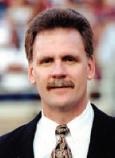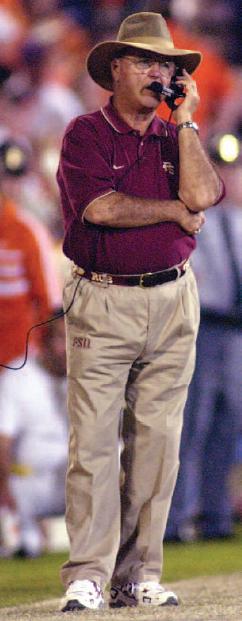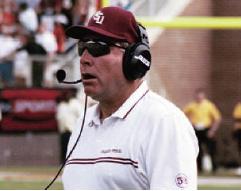How good is FSU athletics? As good as the players and fans decide to be
By Charlie Barnes, Executive Director - Seminole Boosters
 |
Andy Miller |
Two years ago Andy Miller (president of the Boosters) and I enjoyed lunch on a warm day in Inverness. Bob and Linda Fohl and John and Patsy Stewart drove up from Orlando, and we were the guests of Tom and Monkey Hagar at a café in the historic downtown.
The Fohls, Stewarts and Hagars were all in school together at FSU in the 1950s. The conversation turned to stories of the old days, of campus social life in the fifties, and of game-day traditions.
FSU was a smaller campus then. Students knew each other, or at least recognized faces as they walked back and forth to class. Whether the innocence was really there or whether our yearnings for a less complicated time have seduced us is not important. It is important that we find powerfully appealing that timeless vision of simplicity, of discovery, of the recollected joy of college life.
Tom and Monkey talked about the football games, and how fans gathered outside the locker room to applaud the players as they left the stadium. The cynic would say that today, only agents crowd the locker-room door. They might say that today’s college football players are little more than mercenaries soldiering on a training ground for professional sports.
That cynic’s view is popular in some quarters, but it’s false, certainly at FSU. The truth is that across the board, especially at major public institutions, academic standards for student-athletes have never been as high as they are today.
The dark alleys of organized cheating have largely been hosed out and opened to cleansing beams of sunlight. The fact that splashy stories of NCAA rules breaking appear in the papers is proof enough of today’s low tolerance for bad behavior.
Still, there is a longing for the way things were, or the way we remember them. It does exist: the small, friendly campus where college sports is an amusement for the student body, and boys and girls play for the passion of the game, seldom daring to dream of becoming professional athletes.
You can find that very world right now at Presbyterian College, at Hampden-Sydney and at Wofford. It exists at East Central State and Stephen F. Austin State College and at Birmingham Southern.
FSU could go back to that time if we wanted. But, we’d have to really want it. We’d have to leave our stadium behind, along with televised games and sights and sounds and smells of game day. There’d be no more great, milling clouds of fans.
We’d even have to give up our hateful rivals. We’d make do with less passion.
Big time college athletics is a powerful force in our culture, and in our case especially, Seminole athletics creates an emotional infrastructure that draws in and involves our graduates.
In Florida, where changes are the norm, FSU needs alumni with the financial means and the political clout to protect and nourish their university. Orlando attorney Hugo de Beaubien said, “Recently, when President George Bush needed a leader for HUD, an important cabinet position, he called on Mel Martinez of Orlando. When our state needed a new Supreme Court justice last month, we selected Raoul G. Cantero of Miami. When our state needed a new secretary of state this fall, the governor appointed Jim Smith of Tallahassee.”
All are Seminoles.
Some of the most prominent and powerful names in the state emerge from our classes of the 1950s and 1960s. Florida Senate President Jim King isn’t just an alumnus. He was president 20 years ago of the Jacksonville Seminole Booster Clubs.
Former Florida House Speakers T.K. Wetherell and John Thrasher aren’t just FSU graduates. T.K. was a star defensive back for the Seminoles, and then, as a legislator, he fought to get money to build the fabulous University Center.
Thrasher was on the Boosters Board until he resigned to be the first chairman of the FSU Board of Trustees.
Florida has 10 state universities, most in major population centers, and they want all the legislative money that flows to Florida State and Florida. It isn’t personal. They just want the same things that we have always wanted.
Their population base gives them political power.
Florida State is prospering in no small part because of the close attentions of committed alumni leaders. And be assured that many of them came to the university through the locker-room door.
Those wonderful people—the Fohls, Stewarts and Hagars—would not have us give up the gains we’ve made in order to recreate some fond vision of the 1950s. They also remember a collegiate campus atmosphere less commercialized than today’s. They too loved sitting in the wooden bleachers, feeling the wafting breeze late in the day as their friends and classmates fought their hearts out on the field.
But they also recognize that Florida State has advanced from one arena to a higher level of competition. Like many, they have supported this advancement with their hearts and their treasure. Fohl played tight end for the Seminoles, and now he and Linda have created an endowment for the starting tight end’s scholarship. The Hagars and the Stewarts have likewise invested strongly in FSU athletics.
Andy Miller and the Boosters have the responsibility of making sure FSU keeps pace with competitors on the national stage.
It’s our job to communicate what rival programs are building and what motivates young student-athletes to select a school.
 |
Head Coach Bobby Bowden |
Yes, Bobby Bowden and his coaches and our great program have drawn highly talented young men to FSU. We’re raising money to protect against the day when Bobby Bowden is no longer here.
Our fans give a great deal. Individually, they tend to give more than fans of most other schools. To those who feel burdened, I say do what you can do, be happy with what you can do and understand that not every appeal is directed at you personally.
“When will it be enough? When is enough, enough?”
Actually, there is a straightforward and realistic answer to that question. Athletic Director Dave Hart’s annual scholarship cost for all men’s and women’s sports is between $3.5 and $4 million. To ensure that money, we have to build a scholarship endowment of around $80 million at today’s tuition rates.
We currently have an endowment of $20 million under management. Half the Dynasty Campaign’s $70-million goal is for scholarships. By the time it’s collected, our endowment should have more than $60 million. We’ll continue to raise money until the endowment will pay the annual scholarship costs, which are always increasing.
We’ve also been fortunate to raise a great deal of money for facilities. We’ve bond-financed most of those facilities, and we will pay them off with money we’ve raised and money that we will raise.
When the endowment is adequate, and when the facilities are paid for, then I think FSU might consider retiring our Seminole Booster program. Enough will finally be enough. A fully funded endowment and debt-free facilities are not ambitious goals for old-line major universities. Most of our rivals enjoy those very advantages now.
Let me give you a taste of what we’re up against. So far, we’ve had the generous participation of many, many donors. However, our largest single gift to date is $2 million. I’m told the University of Arkansas’ athletic program will receive $300 million from one donor. The University of Missouri athletic program is receiving $150 million from the same donor. Our ACC rival Virginia has received two $20-million gifts to athletics recently.
We made the decision to take on the old, big schools. We’ve been aggressive, enterprising. We’ve been lucky and we’ve been smart, and it’s paid off handsomely. We have come to believe that we can be as good as anyone, attract the best student-athletes in the nation, and compete for national championships in all sports.
“Why bother?” is the question I think some are asking. Why put extraordinary effort and expense toward something that we may not need, and that our fans may not really want.
Here is a good tale about Coach Mickey Andrews. He was frustrated with the results after several days of practice during what would become a national championship season. He just couldn’t connect with his players; he wasn’t able to motivate them to give the effort he wanted.
 |
Defensive Coach Mickey Andrews |
Mickey and his assistants abruptly stopped coaching and walked over to the shade of the big oak tree. They ordered cold drinks, sat and waited. The players stood dumbfounded until a couple of the leaders walked over to ask what was up.
“We’re your coaches, but we can’t make you want to do what you have to do to win. We’re frustrated, and you’re probably mad at us for pushing you, and nothing good is happening.
“Rather than us fighting each other, here’s what we’re going to do. You boys get together and decide how good you want to be and then come back and tell us. We’ll coach you to that level. No hard feelings; you tell us what you’re willing to do and we’ll accept it. If you’re willing to do what it takes to be a 7-4 team, we’ll coach you to be that good. If you decide you want to be national champions, then we’ll coach you that way.”
And that’s where we are. What do we really want, and what are we really willing to do? Mickey’s players gave him their answer. I imagine our Seminole fans and supporters will let us know their answer as well.